Two Ege Leaves and Two Ege Labels in the Collection of Birgitt G. Lopez
May 10, 2022 in Manuscript Studies, Uncategorized
Two Ege Leaves in Frames
with
Two Ege Labels
in the Collection of Birgitt G. Lopez
(Ege MS 14, MS 20, and MS 9 + 54)
Mildred Budny
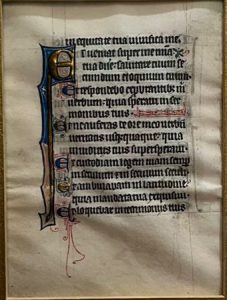
Collection of Birgitt G. Lopez, Framed Leaf from ‘Otto Ege Manuscript 20’, Front-Facing Page (“Recto”).
[Posted on 10 May 2022, with an update]
Acquired separately in Dallas, Texas, over the course of some five years and through the Dallas Public Library, two vellum leaves from manuscripts dispersed through Otto F. Ege (1888–1951) now belong to a single collection, that of Birgitt G. Lopez. The two leaves, differing in size, script, layout, and type of book, come from two different manuscripts from Ege’s collection. With each leaf travelled a printed Label composed and printed by Ege to accompany the dispersed specimens of the particular manuscript.
Each leaf has been reframed. Its identifying Label is retained and taped to the back of the frame. Recently, after a visit to Dallas Public Library to examine its relative from one of those Ege manuscripts, Mr. Lopez contacted me, at the suggestion of the Librarian, and generously offered to share information about both Ege leaves in the collection with our and others’ study of Ege materials.
The Links of Transmission from Otto Ege
When reporting the existence of the leaves to me, Ernesto Lopez recollects that the first leaf was purchased at an auction benefiting the Dallas Public Library. The second was a gift some five years later from Lillian Moore Bradshaw (1915–2010), long-time Director of the Dallas Public Library (1962–1984).
Mr. Lopez reports:
I purchased the first one in an auction benefiting the Dallas Public Library 1998 and the second one was a gift in 2003 from Lillian Bradshaw, the long-time Dallas Public Library Director. Ms. Bradshaw told me at the time that she purchased the items directly from Mr. Ege; I have the letter laying out the provenance in Ms. Bradshaw’s hand. . . . . She told me [that] she was working in the Dallas Public Library’s Director’s office when Mr. Ege came to make a sales call. . . . I served eight years on the Dallas Municipal Library Board where I got to know Mrs. Bradshaw.
Also:
Several months ago, I went to the Rare Books collection at Dallas Public Library to do some research on the two leaves that I own. The Rare Books Librarian gave me your email address so that my two leaves can be added to the body of work your group is doing on the Otto Ege manuscripts.
I framed both of the leaves leaving the explanatory text from Otto Ege on the back of the framed works.
The first leaf is similar to the leaf in the Dallas Public Library collection. It is roughly 15″ by 10″.
With permission, we publish images and report some preliminary research results, which can aid in allowing the leaves to become more widely known in their own right.
The Two Leaves
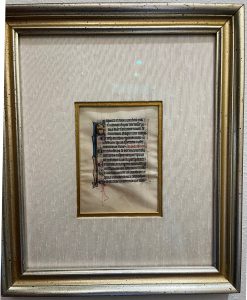
Collection of Birgitt G. Lopez, Framed Leaf from ‘Otto Ege Manuscript 20’. Leaf in Frame. Reproduced by permission.
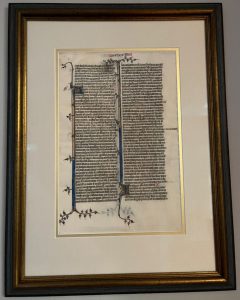
Collection of Birgitt G. Lopez, Framed Leaf from ‘Otto Ege Manuscript 14’. Leaf in Frame. Reproduced by permission.
Each Leaf has a characteristic Ege Label identifying it as the specimen of a Latin Vulgate Bible manuscript, but from different Bibles. One leaf is large-format; the other is small. Within the window of its mat, the outer edges of each Leaf are covered, leaving visible most of the expanse of the page which faces outward, whether originally the recto or verso.
The large-format specimen lays out its text in double columns of 50 lines. The other specimen has a single column of 15 lines.
The one is readily recognizable as a leaf from “Otto Ege Manuscript 14”, a monumental, large-format Latin Vulgate Lectern Bible made in France in the late 13th- or early 14th century. Various of our blogposts over the years have examined its specimens. For example, recently:
- A Leaf in Dallas from “Otto Ege Manuscript 14” (Lectern Bible)
- A Leaf of Deuteronomy from “Otto Ege Manuscript 14” in the Rosenbrook Collection
- Two Old Testament Leaves from ‘Otto Ege Manuscript 14’ at Smith College.
The other leaf belongs to an Ege manuscript that makes a new appearance in our blog, although other leaves from it have come into view directly in the course of my research on various Ege Portfolios and individual leaves. An example from a Private Collection is newly published below, in a full-page view, from an Ege Portfolio which we have already begun to explore in a close-up.
While the Leaves attest to their part in the former manuscripts, their Labels contribute in several ways to knowledge of practices in distributing Ege manuscript fragments — a subject explored in some of our earlier blogposts. See, for example, A Leaf from “Otto Ege Manuscript 19” and Ege’s Workshop Practices.
Both Labels carry annotations, as not infrequently among Ege Labels. Unusual (in my acquaintance) is the application of one Label for one Ege manuscript to a different one, manifesting some confusion or interference in the process of placing Labels and Leaves together correctly.
Happily, a handwritten letter to the owner from a former Librarian at the Dallas Public Library, who had purchased it from Otto Ege directly, keeps company with the Leaves as a record of the direct chain of transmission.
The Librarian’s Letter
In its own frame, the letter accompanying one of the leaves tells its own graceful story. It came from Lillian M. Bradshaw (1915–2010), Director of the Dallas Public Library (1962–1984).
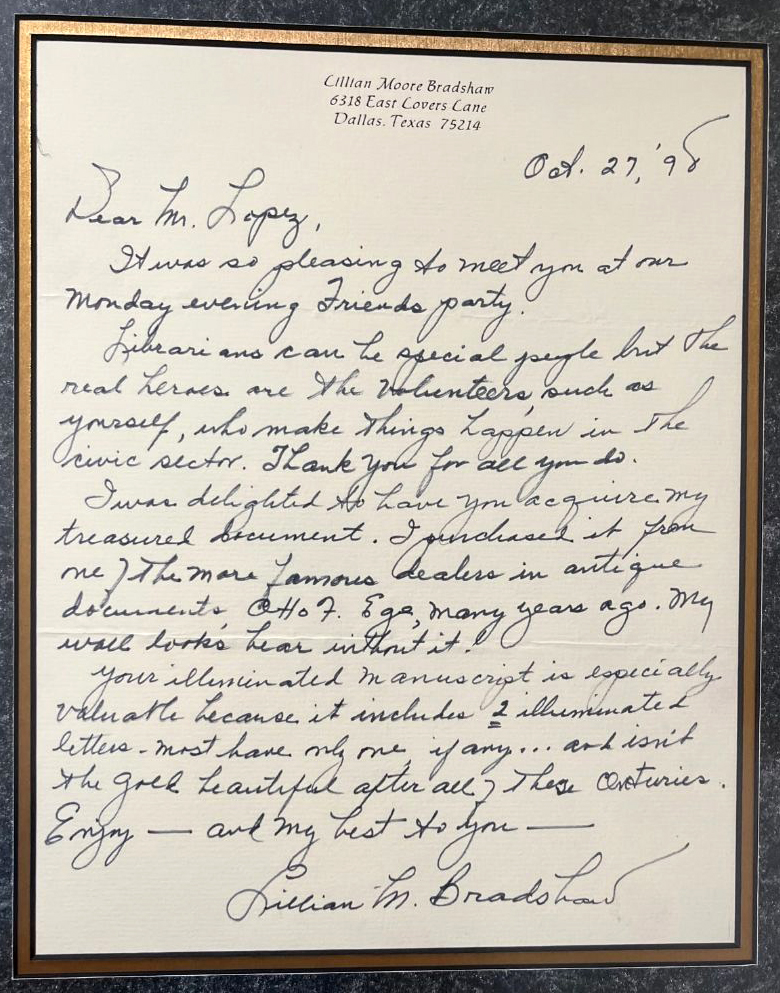
Collection of Birgitt G. Lopez, Framed Letter from Lillian Moore Bradshaw, signed and dated 27 October 1998.
Dated “Oct. 27, ’98”, on the letterhead of “Lillian Moore Bradshaw” at home in Dallas, the holograph letter reads:

Photograph portrait of Lilian Moore Bradshaw, via Wikipedia and Creative Commons.
Dear Mr. Lopez,
It was so pleasing to meet you at our Monday evening Friends party.
Librarians can be special people but the real heroes are the volunteers such as yourself, who make things happen in the civic section. Thank you for all you do.
I was delighted to have you acquire my precious document. I purchased it from one of the more famous dealers in antique documents, Otto F. Ege, many years ago. My wall looks bare without it!
Your illuminated manuscript is especially valuable because it includes 2 illuminated letters. Most have only one, if any . . . and isn’t the gold beautiful after all these centuries. Enjoy — and my best to you —
Lillian M. Bradshaw
The observation that “My wall looks bare without it!” indicates that the Leaf, in her collection, had a place of hanging display, as a way to maintain its presence for viewing frequently in the course of activities, whether domestic or occupational.
The Two Ege Labels
Both Leaves retain the rectangular printed Labels which accompanied them to their current collection, after which the Leaves were reframed. The Labels are now taped to the back of their frames; each Label retains an unevenly trimmed remnant of its former mat, which extends partly beyond the edges of the Label. Both Labels show many signs of wear, and both have annotations in pencil or both ink and pencil.
The First Label (for Ege Manuscript 14)
The Label for the large-format Leaf from Otto Ege Manuscript 14 represents the standard formula for Ege’s Leaf 14 in the FOL Portfolio. That is, the collection of Fifty Original Leaves from Medieval Manuscripts, Western Europe, XII–XVI Century (see, for example, ege.denison.edu). The printed number ‘14’ is only partly visible at the top right, with the integer 1 in sight; the 4 would presumably appear beyond the edge of the photograph.
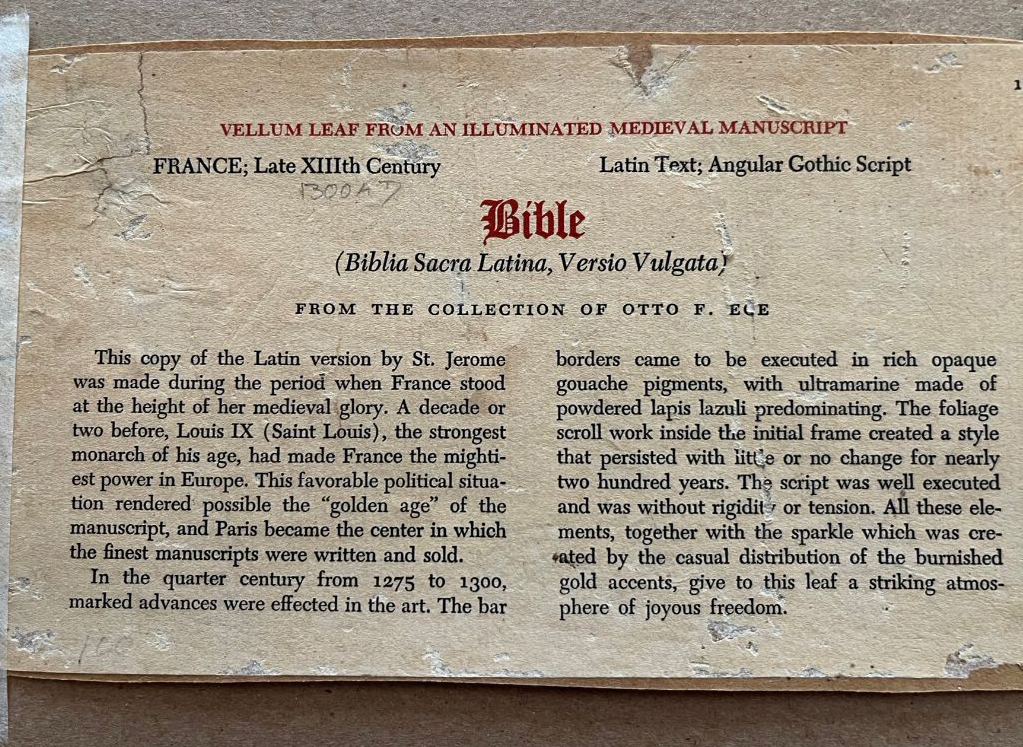
Collection of Birgitt G. Lopez, Framed Leaf from ‘Otto Ege Manuscript 14’, Ege Label on back of the frame.
The Label has two pencil annotations. Below the printed heading “XIIIth Century” at upper left, there is added an equivalent or alternate: “1300 AD”. At bottom left, a faint or partly effaced number “1 00” apparently lists the price (in US currency), probably $1.00.
Undamaged and un-annotated Labels show the former state more clearly, as with the example pertaining to Leaf 14 in the FOL Portfolio at Stony Brook University. There, the Label still stands in original position at lower left on the front of the mat.
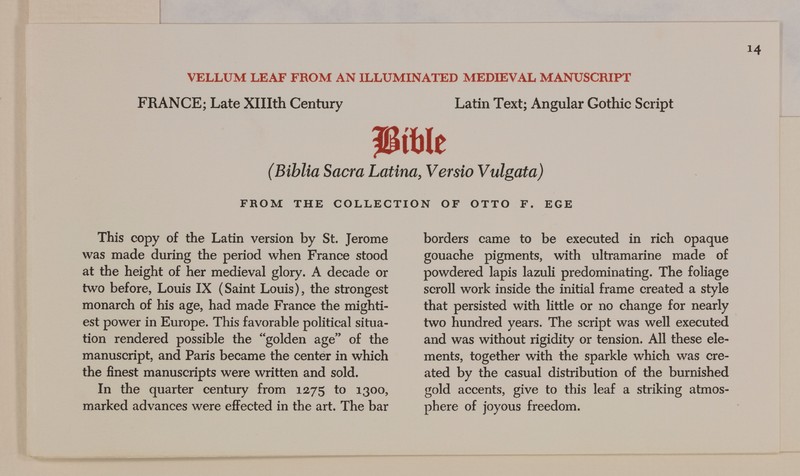
Otto F. Ege: Fifty Original Leaves from Medieval Manuscripts, Leaf 14, Printed Label, Special Collections and University Archives, Stony Brook University Libraries.
The Second Label (for Ege Manuscript 54)
The second Label identifies it as “A LEAF FROM / ST. JEROME * VULGATE BIBLE”, from a copy of Saint Jerome’s Latin translation of the Bible. In this case, it is a “Dominican Manuscript Written in Paris, circa 1240”. The 2-paragraph caption begins: “Hieronymus, more generally known as St. Jerome, finished his Herculean task, the preparation of the ‘Edition of Holy Scriptures in General Use,’ or the Vulgate Bible, in the year 414 A.D. . . . ”
The same label keeps its original place on the Ege mat in copies of the Famous Books Portfolio such as the set now in a Private Collection which has made an appearance in our blog for its specimens from other Ege manuscripts. See:
- Otto Ege’s Portfolio of ‘Famous Books’ and ‘Ege Manuscript 53’ (Quran)
- Otto Ege’s Aquinas Manuscript in Humanist Script (‘Ege Manuscript 40’)
The label:

Collection of Birgitt G. Lopez, Otto Ege Label for “Ege Manuscript 54”.
The caption in full:
Hieronymus, more generally known as St. Jerome, finished his Herculean task, the preparation of the ‘Edition of Holy Scriptures in General Use,’ or the ‘Vulgate Bible,’ in the year 414 A.D. Fourteen years were spent in reading and checking the innumerable texts in Latin, Greek, and Hebrew. The latter language Jerome began to learn only at the age of forty. This Vulgate version of the Bible is one of the most important ever compiled. It became the standard Bible of the western world for over a thousand years, although it required several hundred years to win the place it deserved. It gave birth to ecclesiastical Latin, the international language of the medieval world. Many of the existing letters of Jerome give us a picture not only of his violent / temper, but also of the resulting controversies regarding his version of the Bible. In one, he called a critic “a two-legged ass”, he accused some copyists of “being more asleep than awake”.
With almost superhuman skill and patience, and without the aid of eyeglasses, the Dominicans produced a large number of these “Miniature” or “Portable” Bibles to be used in the Sorbonne, the newly established school of theology of the University of Paris, as well as by the wandering friars of this order. The well executed gothic book-hand of nine lines of writing to an inch was done with a crow or eagle quill. The vellum used was obtained from the internal organs of newly born sheep or calves and is finer than our present “india” paper. Four hundred leaves measure slightly less than an inch in thickness.
The Annotations
In the lower margin of the Label in the Collection of Birgitt G. Lopez, there appear annotations by different hands. Notes cite the price twice in pencil: as “$15.00” below the left-hand column of the caption, and as “15 oo” to the right of the printed name of the author, “Otto F. Ege”. At the far left a larger pencil entry cites the number: “# 6”, labeling the specimen Leaf in some sequence. Inscribed by the owner, a 2-line entry in cursive script in ink to the left of Ege’s name records the source of the Leaf and a date: “From Lillian M. Bradshaw / 5/13/03”.
These annotations provide an important record of the journey of the leaf, in an exchange that is not grounded upon a currency, but in affinity and respect.
The Manuscript Matching the Label (Ege Manuscript 54)
The Label corresponds to one of the portable Vulgate Bible manuscripts which Ege distributed in more than one of his Portfolios. The manuscript provided specimen leaves for two different Portfolios, dedicated respectively to Famous Books and to Famous Bibles. In some collections, it is possible to consult them side by side:
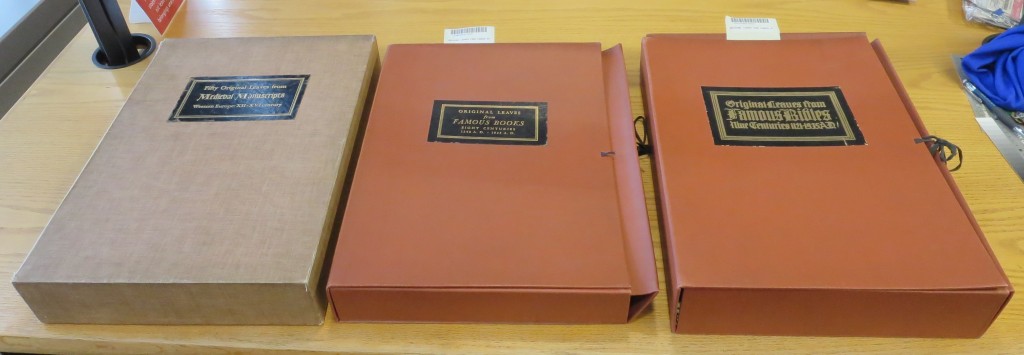
Three Ege Portfolios. “Fifty Original Leaves from Medieval Manuscripts”, “Original Leaves from Famous Books” (Series A in “Eight Centuries”), and “Original Leaves from Famous Bibles” (Series B in “Nine Centuries”). From the Collection of The Public Library of Cincinnati and Hamilton County. Photograph by Mildred Budny.
Depending upon variables by which those two Portfolios were filled, it served sometimes in one or other:
- In the shorter Portfolio (of two) of Original Leaves from Famous Books in Eight Centuries (FBEC), as Leaf 1
- In the longer Portfolio (of two) of Original Leaves from Famous Bibles in Nine Centuries (FBNC), as Leaf 2.
On the Portfolios, Books (in 8), and Bibles (in 9), see respectively Scott Gwara, Otto Ege’s Manuscripts: A Study of Ege’s Manuscript Collections, Portfolios, and Retail Trade, with a Comprehensive Handlist of Manuscripts Collected and Sold (Cayce, South Carolina: De Brailes Publishing, 2013), Appendix III (pp. 100-101); and Appendix IV (p 102). See also now The Guide to the Otto F. Ege Collection by Hannah Goeselt.
Grouping together its specimens shared between different Portfolios, this Vulgate manuscript occupies the position in Scott Gwara’s Handlist (“HL”), as HL 54 (p. 137).
The Label with the Leaf from the auction for the Dallas Public Library corresponds to the Label for specimens in FBEC, as reported (but not illustrated) for some of its online sets. For example:
- Missouri State University, Special Collections and Archives (FBEC)
https://cdm17307.contentdm.oclc.org/digital/collection/Medieval/id/99
- Los Angeles, Loyola Marymount University, Department of Archives and Special Collections, William H. Hannon Library (FBEC)
Original leaves from famous books : eight centuries, 1240 A.D.–1923 A.D.
1 [original verso]
https://digitalcollections.lmu.edu/documents/detail/12169
2 [original recto] with a medieval folio number in ink at the top right: 348
https://digitalcollections.lmu.edu/documents/detail/12169?item=12170
The Loyola Marymount College leaf bridges the transition between Epistles I and II to the Corinthians, as it provides the end of Corinthians I, the brief prologue to Corinthians II, and the opening of that Book, with enlarged and decorated initials P for both openings, placed low in column a on the ‘front’ of the leaf as Ege arranged it. The ‘back’ of the leaf is the original recto.
Some other online sets illustrate the leaves, but few refer to the Labels which might or might not still accompany them. Examples from different sets of the Portfolio of Famous Books in Eight Centuries include:
- Cambridge, Massachusetts, Harvard University, Houghton Library, B 4406.657, no. 1, with part of the Book of Leviticus
A view from a set in a Private Collection shows the unnumbered Label for Ege MS 54 (like the Label above) in place on the mat containing its leaf.
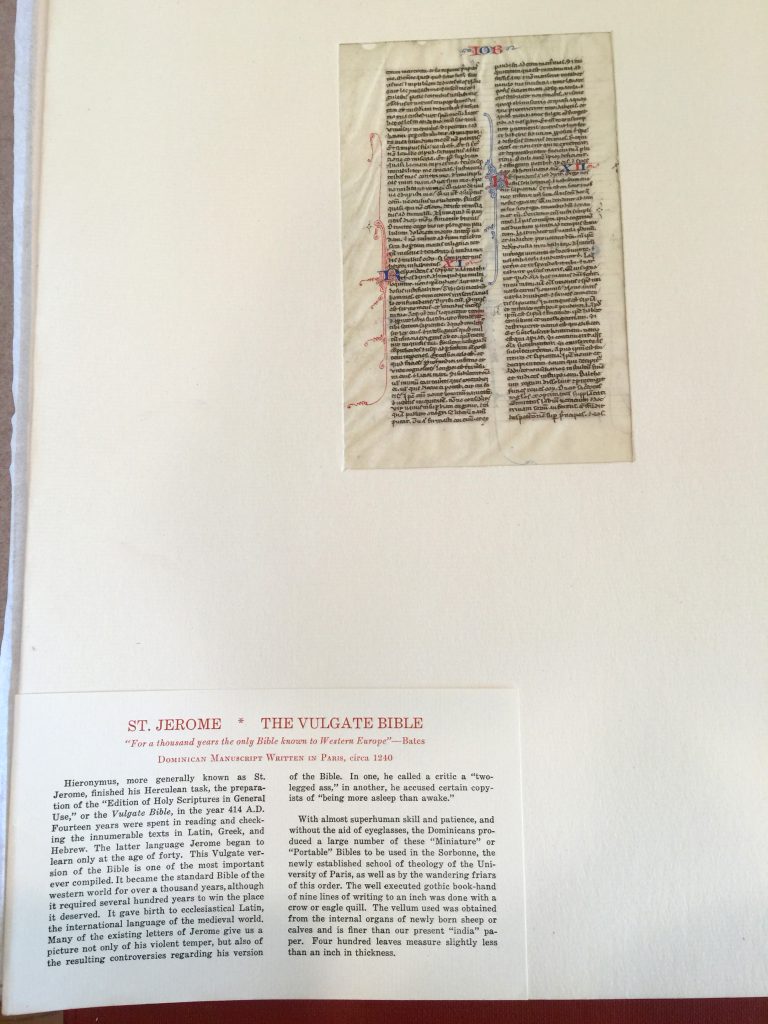
Private Collection, Otto Ege’s Portfolio of Famous Books in Nine Centuries, Leaf from Ege Manuscript 54, Original Recto (turned to the “Verso” in Ege’s Mat). Reproduced by permission.
Further exploration might reveal the form of the Label for the appearances of specimens among the Famous Bibles in Nine Centuries.
The “Dominican Bible”
Ege’s Label for Otto Ege Manuscript 54 refers to a specific Portable Dominican Bible, made in France, circa 1250, with leaves measuring circa 170 x 124 mm <written area circa 11 x 77 mm> and with text laid out in double columns of 53 lines.
An example (previously unpublished) from a set of the Portfolio of Famous Books in Eight Centuries, with part of the Book of Job:
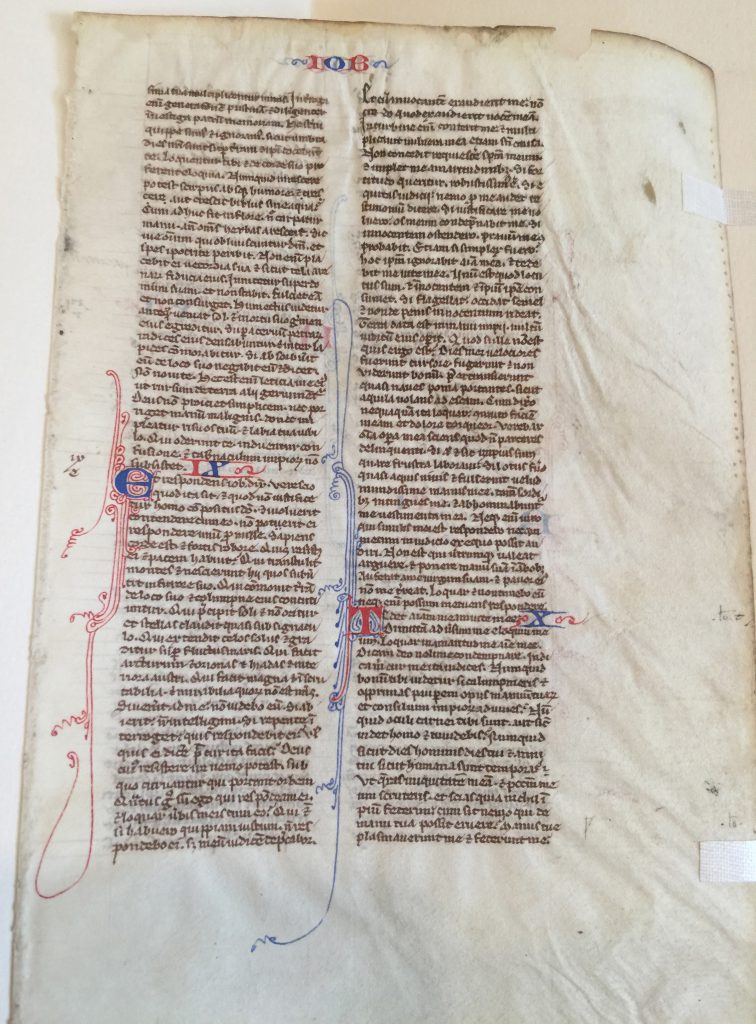
Private Collection
, Otto Ege’s Portfolio of Famous Books in Nine Centuries, Leaf from Ege Manuscript 20, Original Recto (turned to the “Verso” in Ege’s Mat). Reproduced by permission.
This image publishes for the first time the full page of an example from a Private Collection, in an Ege Portfolio which we have already begun to explore, and to which we aim to return.
In the case of the Leaf in the Collection of Birgitt G. Lopez, however, the Label does not match the Leaf. It must have shifted from one specimen to another at some point in distributing the labeled (and matted) Leaf. Discerning the identity of the former manuscript must depend on features of the Leaf itself.
Now we turn to the two Leaves, one by one.
The Large Leaf (Ege MS 14)
The large-format leaf from Ege MS 14 carries part of the text of the Old Testament Book of Deuteronomy. The visible page has two enlarged and decorated initials for Chapter openings IX and X, as the span of text extends from within Chapter 8 to the first five lines of Chapter 10. The Chapter initials are inset within indented spaces at the left-hand side of three lines or four lines respectively: A for Audi and I for In.
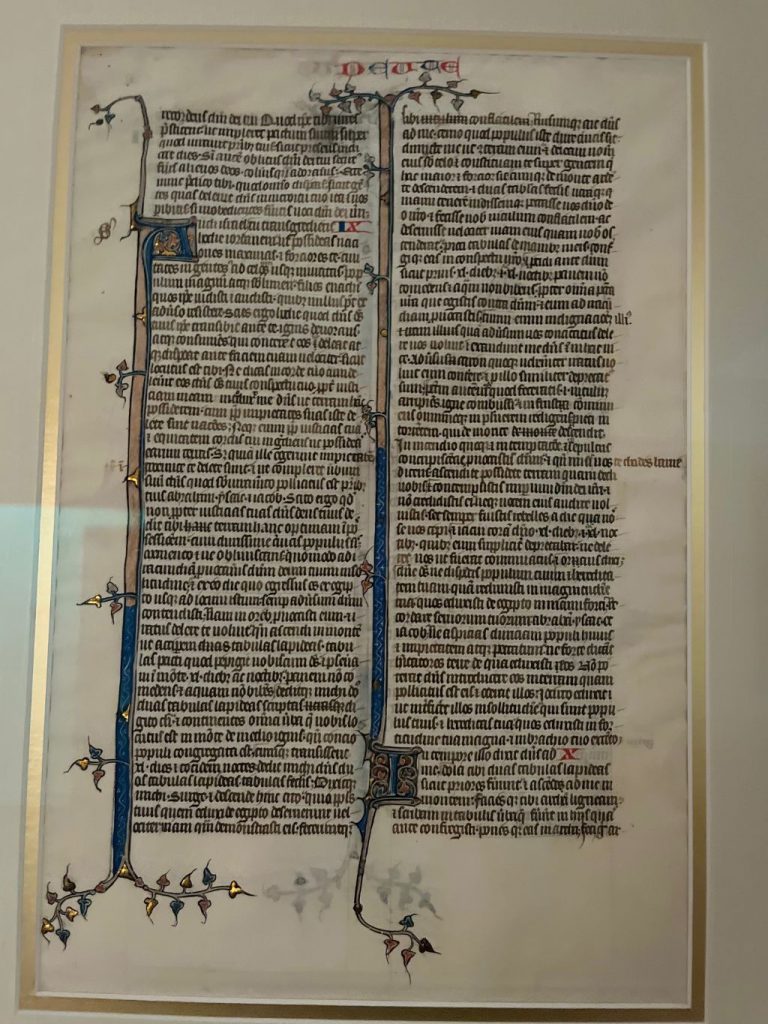
Collection of Birgitt G. Lopez, Framed Leaf from ‘Otto Ege Manuscript 14’.
The Upper Half
The text on the page begins with the second word of Verse 8:18 (recorderis Domini . . . ). Centered in the top margin appears the first part of the running title. Show-through from the opposite side of the Leaf reveals part of its running title and parts of the decorated vertical bar extending the full length of the intercolumn and expanding with a branching foliate terminal into the upper and lower margins. To judge by these offsets, the other side of the Leaf has one ornamental initial, in its right-hand column (column ‘b’), whereas the facing side has two, with a chapter initial in both columns. (‘a’ and ‘b’).
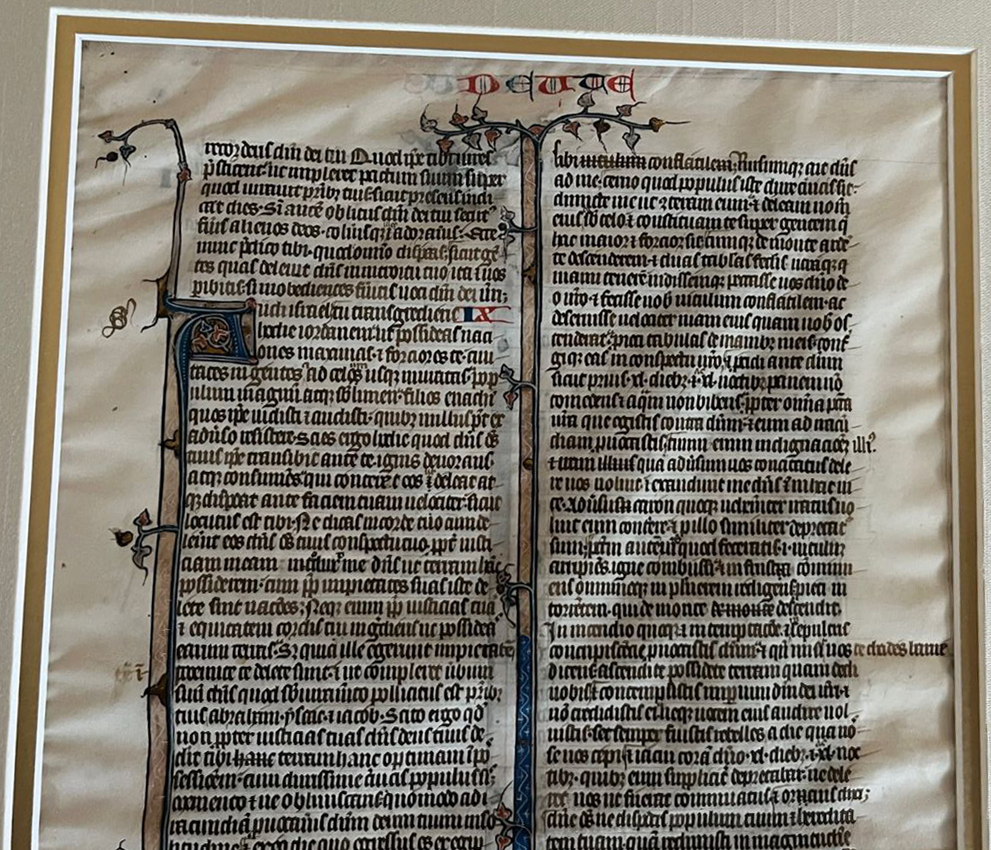
Collection of Birgitt G. Lopez, Framed Leaf from ‘Otto Ege Manuscript 14’, “Recto”, top half.
The Lower Half
The text ends with mid-word within Verse 10:3 (feci igitur ar-[/cam de lignis]).
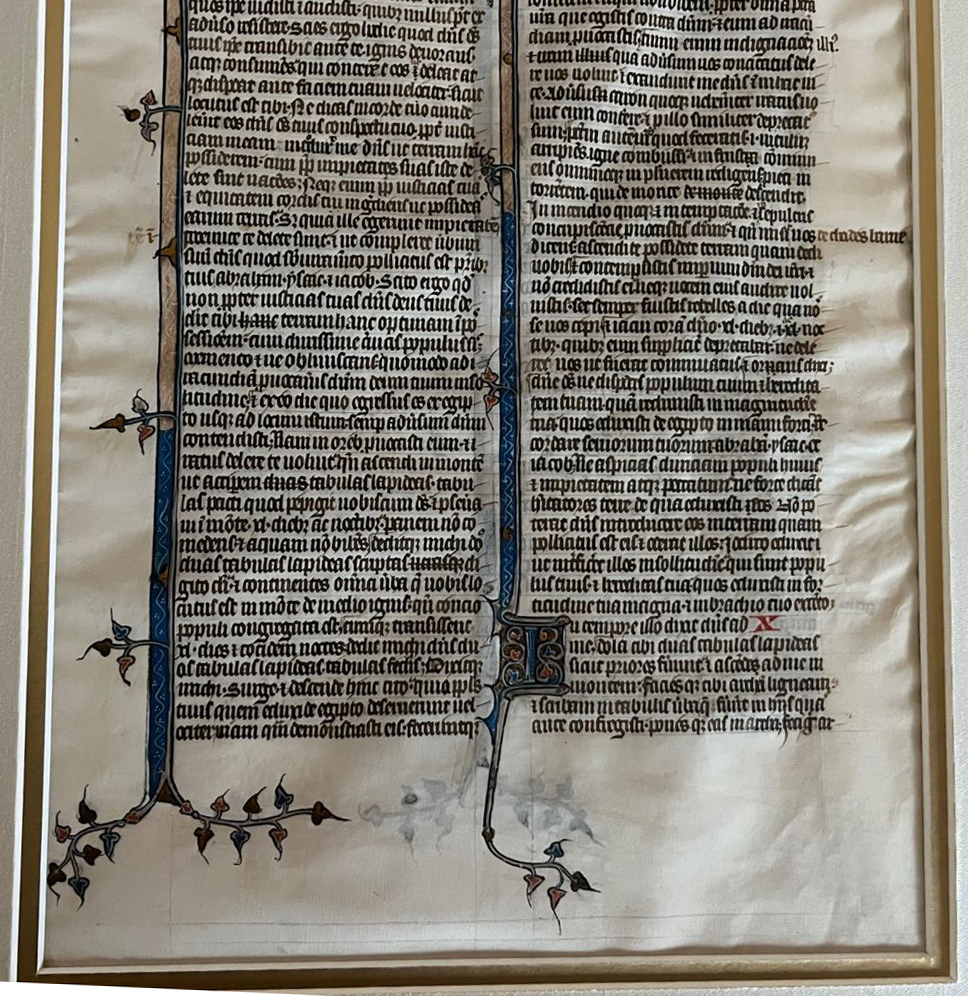
Collection of Birgitt G. Lopez, Framed Leaf from ‘Otto Ege Manuscript 14’, “Recto”, bottom half.
The Lower Right
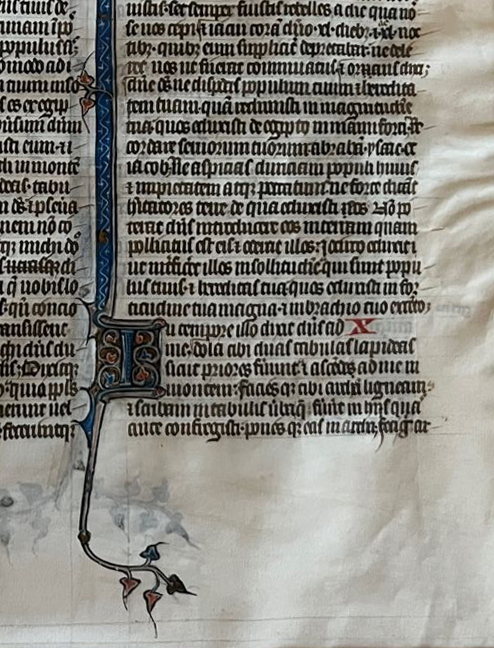
Collection of Birgitt G. Lopez, Framed Leaf from ‘Otto Ege Manuscript 14’, “Recto”, bottom right.
In sum, this page of the Leaf accounts for the following span of text:
Collection of Birgitt G. Lopez, Framed Leaf from Ege MS 14 (one side only is visible)
- Deuteronomy 8:18 [. . . praestiterunt sed / ] recorderis Domini . . . feci igitur ar-[/cam de lignis . . . ]
Its Place in the Manuscript
For the Book of Deuteronomy in Ege MS 14, the survival and whereabouts of leaves preceding this portion are unknown.
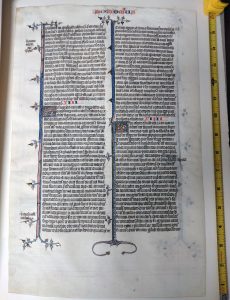
Brent Rosenbrook Collection, Leaf from Ege Manuscript 14, ‘Recto’ (original verso).
The recent discovery of part of Deuteronomy in the Leaf from the Brent Rosenbrook Collection accounts for the next known part of the text:
Brent Rosenbrook Collection, Leaf from Ege MS 14
- Deuteronomy 11:21 ([quam iuravit] /) dominus patribus)
– 14:15 (strutionem ac noc-(/tuam et larum])
A Leaf of Deuteronomy from “Otto Ege Manuscript 14” in the Rosenbrook Collection
Given the span of text on visible page of the “Bradshaw/Lopez” Leaf, and the extent of the textual gap between it and the Rosenbrook Leaf, that is, only from partway through Chapter 10 to partway through Chapter 11, it seems reasonable to expect that the “missing” portion is to be found on one page rather than one whole leaf. A single Chapter Initial (plus ornamental vertical bar) would suffice for that page.
Consequently, the visible page would be the original recto, and the interval could stand on the verso (hidden from view rather than lost). It appears that the Lopez Leaf and the Rosenbrook Leaf were consecutive within the manuscript.
Like that leaf, the first half of the partial running title DEUTE– stands on the recto, in seemingly dislocated position, to leave the second half on the facing verso, as well as on the following verso. See A Leaf of Deuteronomy from “Otto Ege Manuscript 14” in the Rosenbrook Collection.
Such a pattern reinforces the conjecture that this position was deliberate in the design of this part of the book. Like the Rosenbrook Leaf and some other leaves, the Lopez Leaf might bear the feria number in small cursive script at the top right. If so, it would be hidden behind the mat.
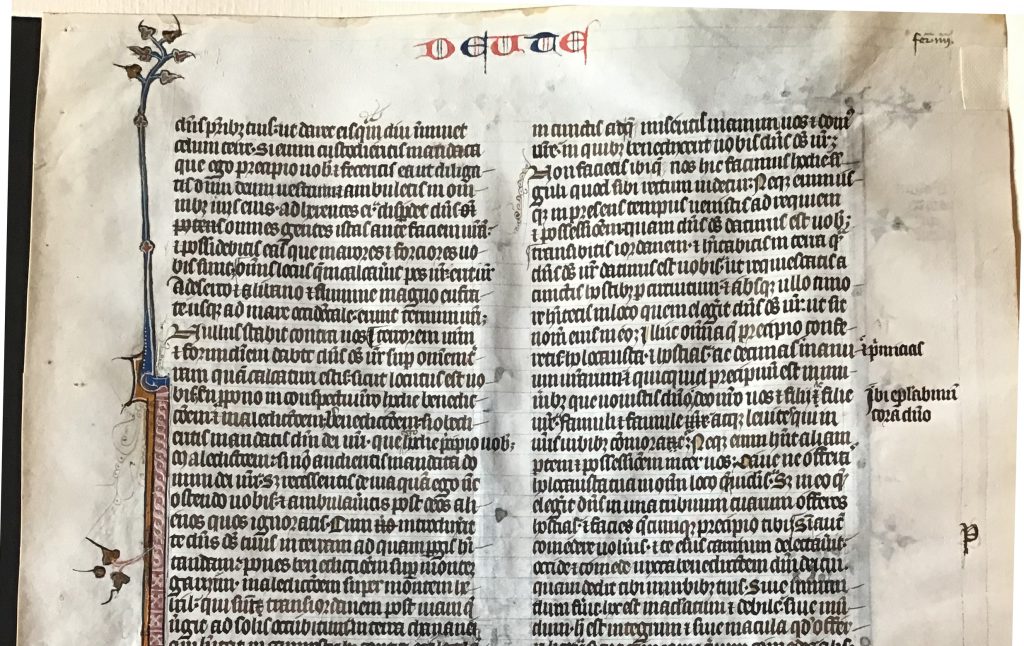
Brent Rosenbrook Collection, Leaf from Ege Manuscript 14, ‘Verso’ (original Recto), top.
The Small Leaf (Ege MS 20)
The visible side of the small Leaf has part of the text of the Book of Psalms. Its single column of 15 lines of upright Gothic script carries verses of the long Psalm 118 from within Verse 41 to within Verse 46:
[. . . mandata tua / ] in aequitate tua vivifica me . . . Et loquebar in testimonis tuus [ / in conspectu regum . . . ]
Verse 41 has an enlarged initial E for Et, partly inset within the indented area of 3-line height. The shorter initials for five other verses stand partly outside the lines of text and rise to 1-line height. Rendered in red pigment, a horizontal decorative space filler adds additional embellishment and colorful contrast to the block-like column of script.
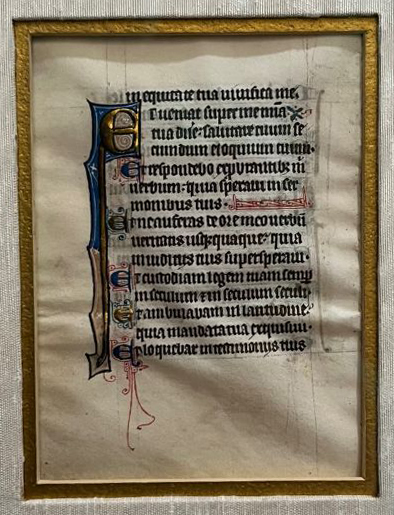
Collection of Birgitt G. Lopez, Framed Leaf from ‘Otto Ege Manuscript 20’, Front-Facing Page (“Recto”).
Among Ege manuscripts which have text in single columns (as listed in Gwara’s “Index of Lines per Page by Number of Columns”, pp. 341–343, at p. 341), it is possible readily to identify this one as Ege Manuscript 20, employed for specimens in the FOL Portfolio.
Ege labeled it as a Psalter from “THE NETHERLANDS; Early XIVth Century. Latin Text”, in “Angular Gothic Script. Psalter (Psalterium).” Gwara, HL 20 (pp. 124–25) and fig. 80, identified it as “Flanders, 1275–1300): 126 × 92 mm (written area 70 × 47 mm). Single columns, 15 lines.”
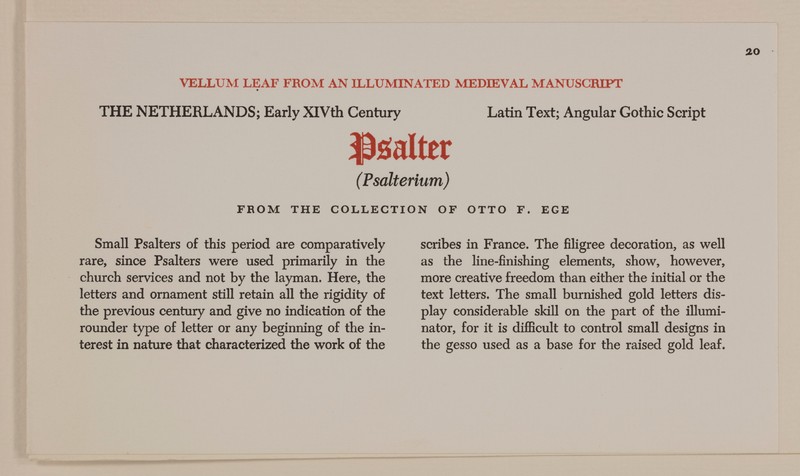
Otto F. Ege: Fifty Original Leaves from Medieval Manuscripts, Leaf 20, Printed Label, Special Collections and University Archives, Stony Brook University Libraries.
In Ege’s words:
Small Psalters of this period are comparatively rare, since Psalters were used primarily in the church services and not by the layman. Here, the letters and ornament still retain all the rigidity of the previous century and give no indication of the rounder type of letter or any beginning of the interest in nature that characterized the work of the scribes in France. The filigree decoration, as well as the line-finishing elements, show, however, more creative freedom than either the initial of the text letters. The small burnished gold letters display considerable skill on the part of the illuminator, for it is difficult to control small designs in the gesso used as a base for the raised gold leaf.
Among other shared elements, the decorative horizontal space-fillers and vertical bar-like extensions from larger initials stand out as comparable characteristic features. For example:
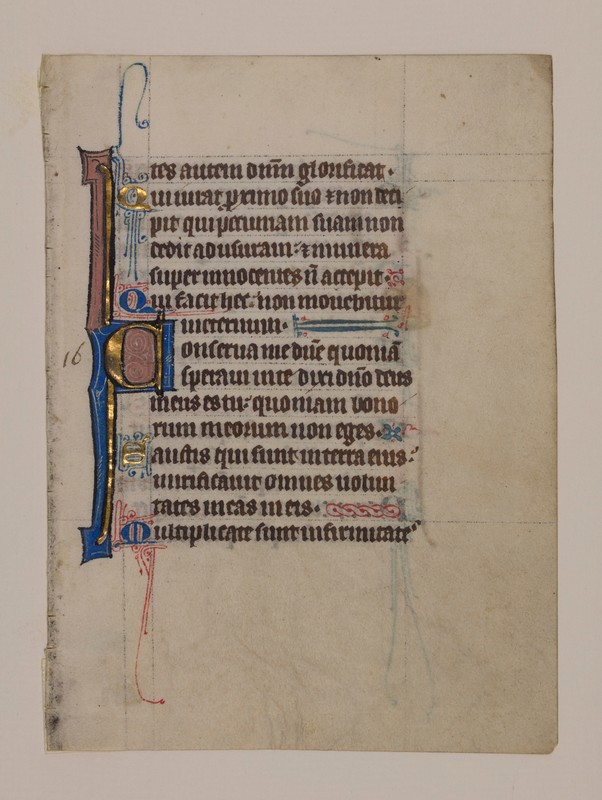
Otto F. Ege: Fifty Original Leaves from Medieval Manuscripts, Leaf 20, Recto, Special Collections and University Archives, Stony Brook University Libraries.
Other examples include:
- The Newark Public Library, Special Collections Department, 50 Original Leaves from Medieval Manuscripts, Leaf 20. Psalter (Psalterium)
- Massey College, University of Toronto Libraries, Medieval Manuscripts, Fifty Original Leaves . . . , Leaf 20
- Ohio University Libraries, Mahn Center for Archives and Special Collections, Ege Leaf 20
- Rochester Institute of Technology, Rochester Institute Libraries, Cary Graphic Arts Collection, Psalterium: fragment
- University of South Carolina University Libraries, Irvin Department of Rare Books and Special Collections, Psalter (Ege 20)
Because the “new ” Leaf does not include an opening of a Psalm, with a large initial, it does not carry an annotation in arabic numerals in the margin, as with the numeral 5 on the recto of the leaf at the Ohio University Libraries. For that leaf, the digital facsimile also includes an image of the leaf as framed within the window of Ege’s mat, with the Label standing, as usual, at the lower left outside the front of the mat. See Ege Leaf 20, Recto in window mat.
An Illuminated Specimen in the “Ege Family Portfolio”
Some other leaves from the book contain illustrated elements. The specimen in the “Ege Family FOL Portfolio” (Set number 3) in the Otto Ege Collection at the Beinecke Rare Book & Manuscript Library has its Ege mat, its Ege Label still in situ, and an elaborately decorated and illustrated Psalm initial. This leaf also retains its original stub, turned toward the back beyond the verso.
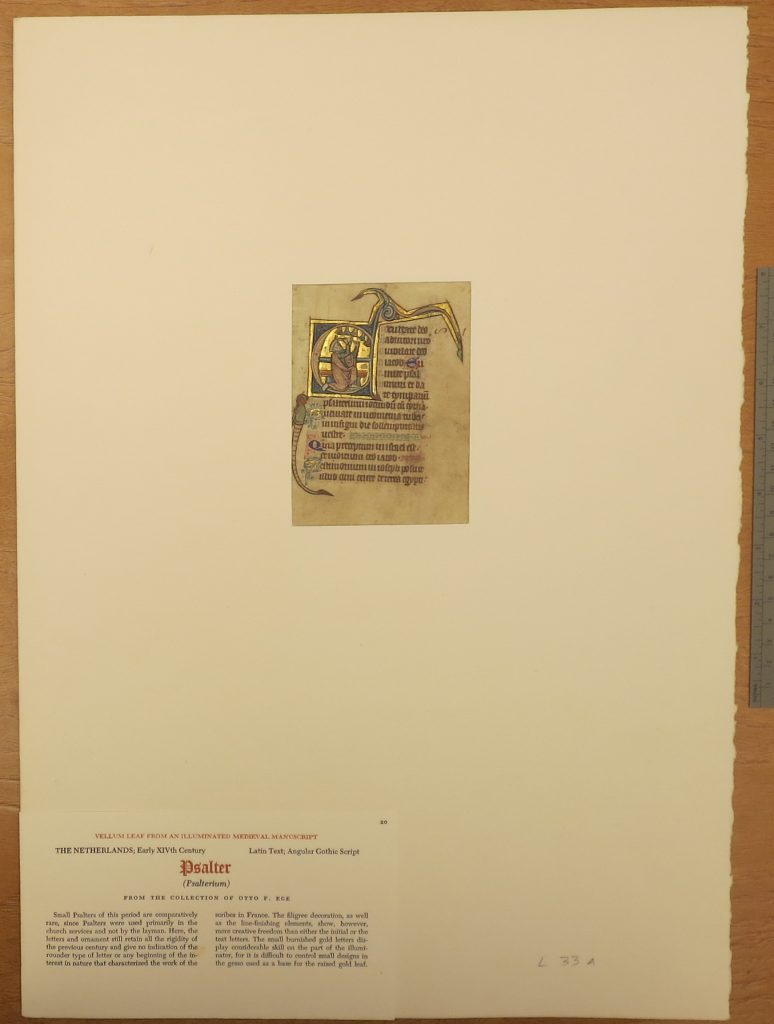
Beinecke Rare Book & Manuscript Library, Otto Ege Collection, FOL Set 3, Leaf 22 in mat. Photography Mildred Budny.
Its Recto Revealed
With the front of the mat lifted, the full extant extent of the leaf is revealed. Front-facing as taped to the back of the mat, the original recto presents the gold-bordered inset initial, 7 lines in height, for the opening of Psalm 80 (81): Exultate deo. Within the initial, the bearded King David kneels as he plays upon a row of five suspended bells. To the lower left in the margin, a hybrid creature with a man’s upper half and a long snake-like tail, blows a horn.
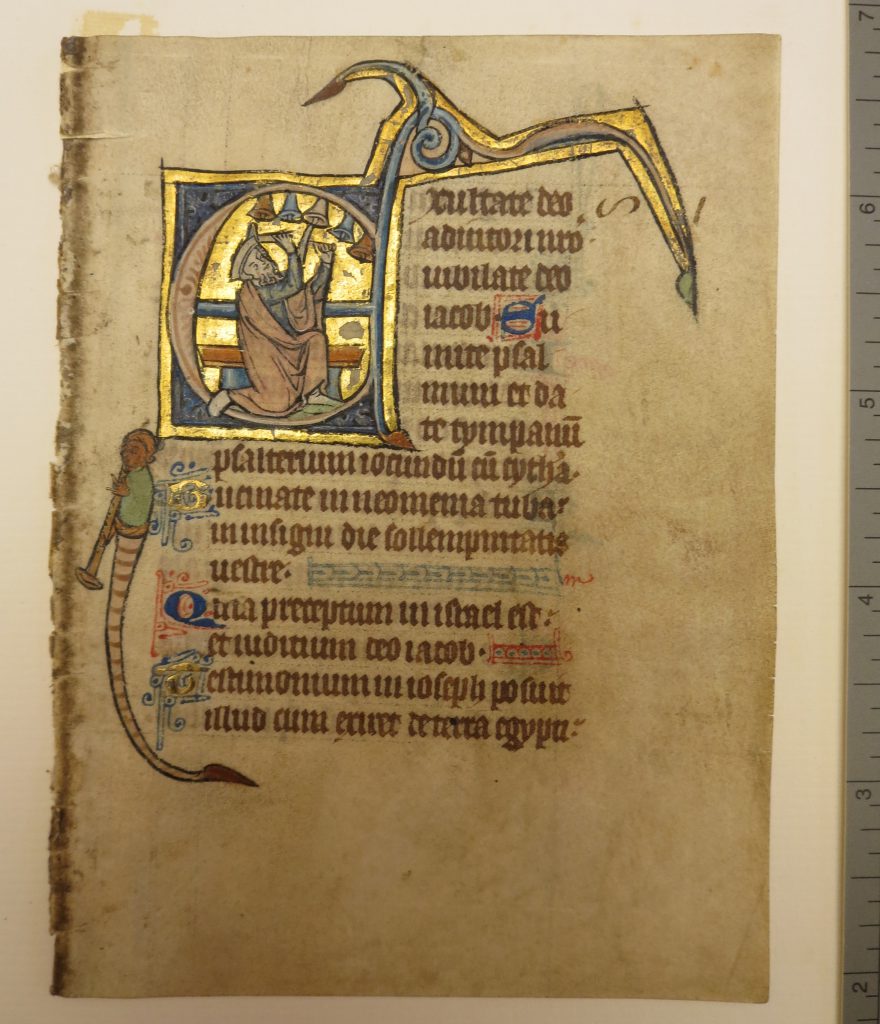
Beinecke Rare Book & Manuscript Library, Otto Ege Collection, FOL Set 3, Leaf 20, recto in full below mat. Photography Mildred Budny.
Its Verso Plus Stub
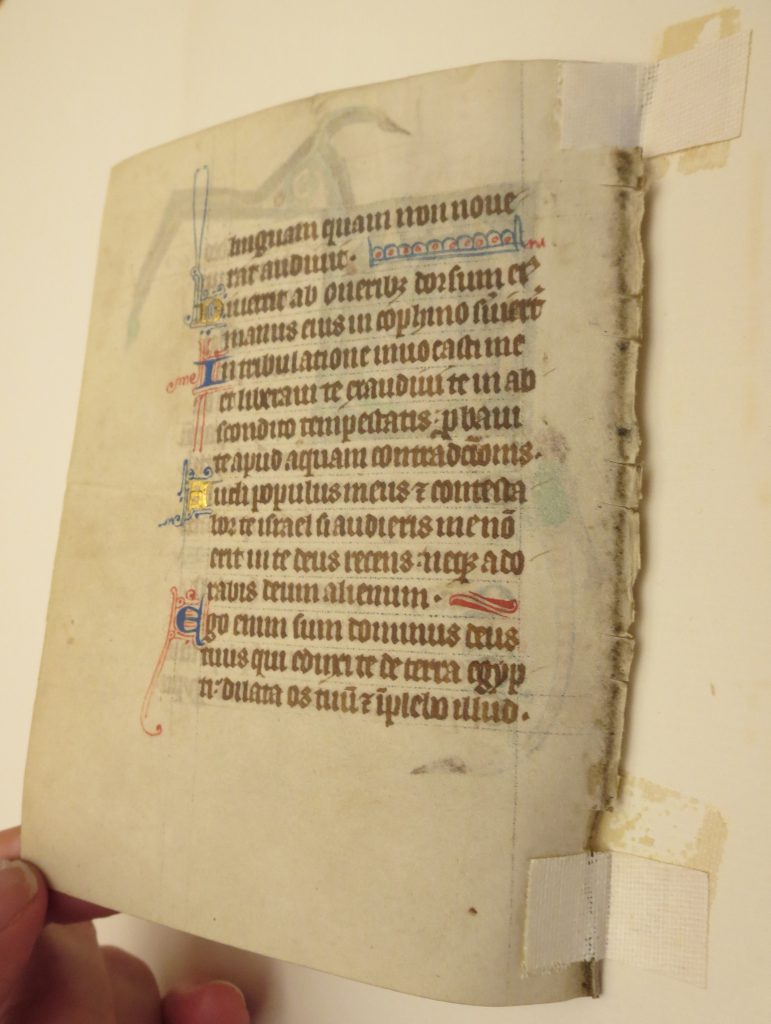
Beinecke Rare Book & Manuscript Library, Otto Ege Collection, FOL Set 3, Leaf 20, verso, partly lifted, with its original stub. Photography Mildred Budny.
The presence and curvature of the stub, extending beyond the fold and stitching line of the original gutter, establishes that the leaf formerly occupied a position in the first part of its quire (or gathering), not the second.
Further research might allow for clearer awareness of the surviving extent of this manuscript.
[Update on 11 May 2022:
Look forward to a study of other parts of “Ege Manuscript 20” in the forthcoming article by one of our Associates in the next issue of the journal Manuscripta: A Journal for Manuscript Research (ISSN 0025-2603):
- Judith Oliver, “A Dismembered Thirteenth-Century Brabantine Psalter” (see Manuscripta (MSS), 65:2 [?]).]
*****
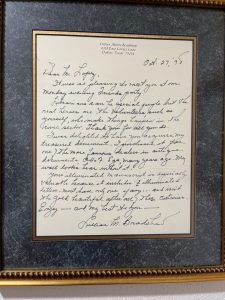
Collection of Birgitt G. Lopez, Framed Letter from Lillian Moore Bradshaw, signed and dated 27 October 1998.
I thank the owner for bringing the two Ege Leaves to our attention, sending images, answering questions, and giving the opportunity to study it and publish it. We are grateful for the permission to reproduce the images here.
We continue to thank the librarians, scholars, students, owners, and others, who have helped the continuing research in many ways.
*****
Do you know of more leaves from these manuscripts? For example, do you know of the presence (sometimes variable) of Ege MS 20 in Ege’s Portfolios of Famous Bibles in Eight Centuries or Famous Books in Nine Centuries, as yet unaccounted-for sets of Famous Original Leaves (FOL), and elsewhere beyond sets of Portfolios themselves?
Do you recognize the hands of these scribes, artists, and annotators in other manuscripts?
You might reach us via Contact Us or our Facebook Page. Comments here are welcome too. We look forward to hearing from you.
Watch our blog on Manuscript Studies for more discoveries. Please visit its Contents List.
P. S. Note that more discoveries for Ege MS 14 await their own blogposts, as more readers of our blog join the conversation. Watch this space!
*****

About the leave of Ms 14 :
Like on the leave of the Brent Rosenberg collection this leave have a letter S for Lectio Secunda from the reading on the previous night (so Feria iii or Tuesday) Again it can be found in the Carthusian Bible of the Grande Chartreuse at the same place “Audi israhel. Tu transgredieris hodie” (Deut. 9,1). https://pagella.bm-grenoble.fr/img-viewer/Ms/Ms0001/viewer.html?base=BMG&np=&ns=B381856103_Ms0001B102r.JPG
The following lesson “Lectio Tertia” or marked with the letter T will be found next to “Et nunc israhel quid dominus deus tuus” (Deut. 10,12).